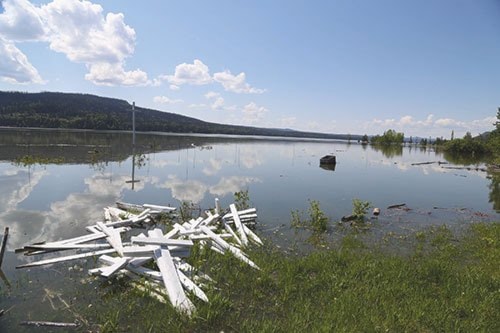The sacred cemetery at Cheslatta Carrier First Nation has flooded again due to high water levels not seen since 2007.
Mike Robertson, the nation’s senior policy advisor, says he expects his people’s remains to be washing up any time now and that it wouldn’t be the first time.
“When the water goes down is usually when we find bones,” Robertson said, adding when Rio Tinto Alcan first opened the Skins Lake Spillway his people found caskets floating in the water.
“We still find pieces of caskets floating to this day.”
Cheslatta First Nation is located 23 kilometres south of Burns Lake on the shores of Francios Lake, a tributary of the Fraser River. In 2007 the nation’s cemetery, which sits along the river bank, was flooded under eight feet of water and remains of the deceased washed up on the shores. Today the grounds are under four feet of water and rising, Robertson said.
“When you go down to Cheslatta Lake and walk the shore you don’t know if you’ll find the leg bone of your brother or the arm bone of your aunt. There are people buried as recent as 1952 so everyone is related and remembers the people in those graves. It’s very disturbing,” he said.
The Cheslatta village and Cheslatta Lake were flooded due to the construction of the Kenney Dam which created the Nechako reservoir, in 1952.
In total the nation has found remains from 15 individuals over the years because of graves being washed away.
Robertson expressed frustration for his nation’s people because, it’s happened so many times, he said.
“We’re frustrated at the haste of things and the events this summer is the reason we need to address these things. It goes back to the design of Kenney Dam. As a cost saving measure they decided to create the spillway but that turned the Cheslatta system into the spillway channel for the Nechako River. The flows seen today are 100 times the natural flow of the Cheslatta. It used to be a menial stream and now you see an ugly brown tyrant,” he said.
In 2012 Cheslatta First Nation proposed to RTA they should build a second release facility at Kenney Dam so the Cheslatta system would not be as greatly impacted.
The proposal is called the Nechako River Legacy Project, and needs to be looked over by RTA along with all other options so they can better manage the water, Robertson said.
“The only safety valve is the Skins Lake Spillway. If something were to occur that spillway is the only outlet. [I think] that’s incredibly unsafe because the spillway is old,” Robertson said.
Rio Tinto Alcan spokesman Kevin Dobbs assures health, safety and the environment are of top priority and that all the company’s infrastructure and operations go through rigorous reviews to ensure they are operated safely and have minimum impacts to the environment.
“The Skins Lake spillway is in very good condition and is inspected twice a year by independent engineers and each week by Rio Tinto Alcan,” Dobbs said.
It was expressed by RTA representatives at a Vanderhoof flood meeting in May that a second spillway would not be feasible.
There is a meeting scheduled between RTA and Cheslatta First Nation at the end of June to discuss the topic.
“Hopefully we’ll be able to report some progress,” Robertson said.
RTA Representatives expressed at a Vanderhoof flood meeting in May that a second spillway would not be feasible.
There is a meeting scheduled between RTA and Cheslatta First Nation at the end of June to discuss the topic.
“Hopefully we’ll be able to report some progress,” Robertson said.
